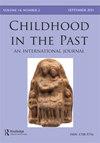20世纪之交尤卡坦henequen庄园儿童死亡率和发病率的历史和考古视角
IF 0.5
Q3 ANTHROPOLOGY
引用次数: 1
摘要
摘要二十世纪之交,墨西哥尤卡坦庄园的工人及其家庭生活条件非常恶劣,疾病和婴儿死亡率高。尤卡坦国家档案馆保存的圣佩德罗·乔鲁尔庄园的死亡记录报告了1871年至1900年间居住在该庄园的人的死亡率数据,包括死因。两岁以下儿童的婴儿死亡率达到54.5%,而五岁以下儿童的死亡率为70.2%。胃肠道疾病、发烧和“alferecía”是一岁儿童婴儿死亡率的特征,而腹泻和发烧主要影响该年龄后的婴儿。五岁以下儿童的男性婴儿死亡率高于女性,但这一趋势在五岁以后发生了逆转。大约四分之一的人死于麻疹、天花和百日咳疫情。在庄园的考古发掘中发现的瓶子也表明了恶劣的生活条件。其中许多含有治疗痢疾、肠道寄生虫和营养不良的药物,也适用于婴儿和儿童。这项历史和考古相结合的调查提供了关于居住在heneque庄园并为其工作的人的发病率和死亡率的见解。它还揭示了他们是如何试图抵消日常生活中遭受的各种疾病的。本文章由计算机程序翻译,如有差异,请以英文原文为准。
Historical and archaeological perspectives on childhood mortality and morbidity in a henequen hacienda in Yucatán at the turn of the 20th century
ABSTRACT Workers and their families in haciendas in the Yucatán, Mexico, at the turn of the twentieth century experienced very poor living conditions, characterized by diseases and high infant mortality. The death records for the hacienda San Pedro Cholul stored at the Yucatán State Archive, reports mortality data for people living in the hacienda between 1871 and 1900, including cause of death. Infant mortality for children under two years of age reached 54.5%, while it was 70.2% for children under five years of age. Gastrointestinal disorders, fever, and ‘alferecía’ characterized infant mortality in children aged one year, while diarrhoea and fever mostly affected infants after that age. Male infant mortality predominated over that of females in children less than five years of age but the trend reversed after that age. About one quarter of people died during measles, smallpox and whooping cough epidemics. Harsh living conditions are also suggested from the bottles retrieved during archaeological excavations of the hacienda. Many of these would have contained medical treatments against dysentery, intestinal parasites and malnutrition, and were intended also for infants and children. This combined historical and archaeological investigation provides insights in relation to the morbidity and mortality of the people who both lived at and worked for the henequen haciendas. It also reveals how they tried to counteract the numerous and varied ailments they suffered during their everyday lives.
求助全文
通过发布文献求助,成功后即可免费获取论文全文。
去求助
来源期刊

Childhood in the Past
Social Sciences-Anthropology
CiteScore
0.90
自引率
0.00%
发文量
16
期刊介绍:
Childhood in the Past provides a peer-reviewed, interdisciplinary, international forum for the publication of research into all aspects of children and childhood in the past, which transcends conventional intellectual, disciplinary, geographical and chronological boundaries. The editor welcomes offers of papers from any field of study which can further knowledge and understanding of the nature and experience of childhood in the past.
 求助内容:
求助内容: 应助结果提醒方式:
应助结果提醒方式:


